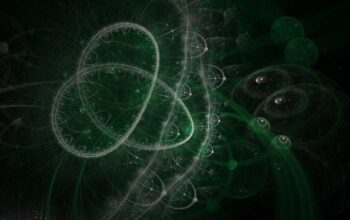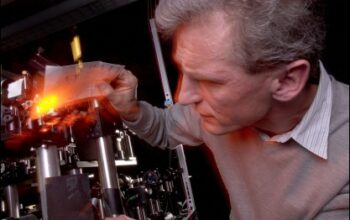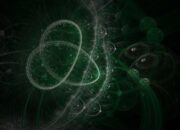In the realm of quantum mechanics, the behavior of particles often defies classical intuitions. Yet, the very nature of these particles engenders a beguiling paradox—a conundrum that can be succinctly captured in the phrase “degenerate yet elegant.” This descriptive juxtaposition beautifully encapsulates the essence of fermions, particularly as researchers delve deeper into their increasingly complex states. The evolution of fermionic behavior, characterized by their half-integer spin and adherence to the Pauli exclusion principle, has rendered them integral to our understanding of fundamental physical phenomena, from the stability of matter to the intriguing properties of superconductors.
At the core of this phenomenon is the concept of degeneracy. When referring to fermions, degeneracy manifests in the form of energy states that can accommodate no more than one particle at a time, due to their intrinsic antisymmetry. This principle underpins the orderly construction of atomic orbitals and the periodic table itself. Consequently, the electrons in an atom fill increasingly higher energy levels, adhering to the fill rule, and creating a structured yet inherently limited hierarchy of states. Observing this from a macroscopic perspective reveals a fascinating equilibrium between chaos and order, where systems strive for the lowest energy configuration while simultaneously remaining robust against perturbations.
One might ponder why this intricate balance provokes such profound fascination. The answer lies not merely in the observable attributes of fermions but also in the subtle implications of their behaviors. For example, the emergence of degenerate Fermi gases elucidates the principles governing the physics of low-temperature systems. At temperatures marginally above absolute zero, fermions aggregate into a degenerate state that provides insight into quantum phenomena, such as superfluidity and the electron behaviors in metals. Not only does this collective behavior challenge classical navigation of particle interactions, but it highlights the inherent beauty of quantum mechanics, where probability and particle identity coalesce into a single tapestry.
Delving deeper, one encounters an array of complex states that characterize fermions beyond their standard depiction. Notably, the exploration of topological phases of matter has garnered significant attention. These states are distinguished not by local order parameters but rather by global properties encoded within the system’s topology. The seminal phenomenon of Majorana fermions exemplifies this concept. Predicted to possess unique non-abelian statistics, Majorana modes hold immense promise in quantum computing due to their potential for fault-tolerant operations. Intriguingly, these particles, existing as their own antiparticles, defy traditional categorizations and prompt a reevaluation of particle classification within quantum field theory.
The investigation into the behavior of fermions also invites contemplation upon symmetry and its breaking. The grand tapestry of particle physics reveals various symmetries, both discrete and continuous, that govern interactions at fundamental levels. When these symmetries are violated, as beautifully illustrated through the electroweak symmetry breaking mechanism, a cascade of phenomena unfurls, leading to mass generation for particles through the Higgs mechanism. This junction of symmetry and fermionic behavior serves as a haunting reminder of the interconnectedness of concepts that span across different scales and realms within physics—from particle interactions to the cosmos.
The aforementioned complexities hint at yet another pivotal aspect of fermionic states—collective excitations. Within solid-state physics, such excitations lead to emergent phenomena, synthesizing simpler interactions into complex behaviors. Understanding these collective modes is critical to elucidating emergent properties in superconductors and correlated electron systems. For instance, when fermions condense into Cooper pairs, a low-energy state emerges, resulting in zero electrical resistance—a hallmark of superconductivity. This highlights both the degeneration of identity within a collective and the elegant interplay of quantum coherence across many particles. The implications are profound, reverberating through technological advancements and energy efficiency.
Yet, the beauty of degenerate fermionic states transcends their practical applications. As physicists ponder the underlying quantum mechanical principles, they unearth philosophical reflections on the nature of reality itself. The exploration of fermionic behavior unravels layers of complexity that lead to inquiries about determinism, probability, and the very fabric of spacetime. At the crux of these modern discussions lies the perennial question regarding the nature of scientific inquiry and understanding—how does one reconcile the apparent randomness of particle behaviors with the underlying deterministic frameworks provided by quantum mechanics?
As the study of degenerate fermions progresses, it continues to redefine the boundaries of our understanding of the universe. The revelations that arise from particle behavior invite a renewed appreciation for the elegance that emerges from complexity. The harmonious interplay between theoretical constructs and experimental observations brings forth an evolving narrative steeped in historical context and contemporary discoveries. As researchers delve into the fascinating world of fermions, they do not merely seek to comprehend; rather, they engage in a profound journey that enriches humanity’s collective knowledge of the vast and intricate cosmos.
In conclusion, the exploration of degenerate yet elegant fermionic states serves as a rich tapestry interwoven with threads of quantum mechanics, topology, and emergent phenomena. Each observation unveils deeper layers of complexity, illustrating not only the operational principles of matter but also the very foundation upon which our universe is built. As these enigmatic particles continue to yield their secrets, we stand at the precipice of understanding, driven by the curiosity that has long characterized the human spirit’s quest for knowledge.







